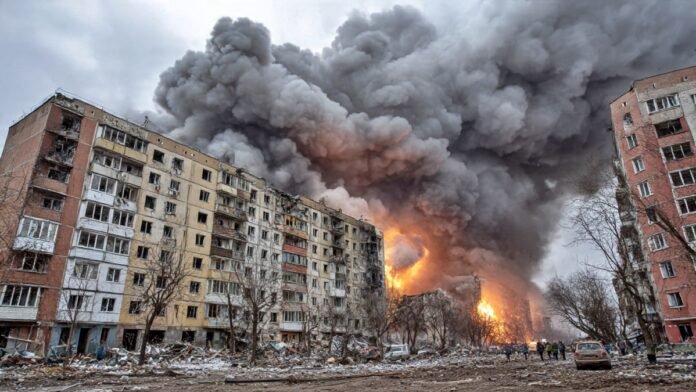
Key Points
- Russia launched 476 strike and decoy drones plus 48 missiles overnight on November 19, 2025, in massive coordinated assault
- At least 25 killed in Ternopil strikes, including children aged 5, 7, and 16, with 73 people injured including 16 children
- Two nine-story apartment blocks in Ternopil hit directly, with 19 people burned alive and more than two dozen still missing
- Ukrainian air defenses shot down 41 of 47 cruise missiles, with F-16 and Mirage-2000 jets intercepting at least 10 missiles
- Zelenskyy met Turkish President Erdoğan hours after attack to discuss peace efforts and garner international support
The war between Ukraine and Russia has reached another dangerous and deadly turning point after Russia launched one of its most massive aerial assaults of the conflict. Russia unleashed a devastating drone and missile strike targeting multiple Ukrainian cities, with the western city of Ternopil suffering catastrophic casualties early Wednesday morning, November 19, 2025. At least 25 people were killed in the Ternopil attack, including three children aged 5, 7, and 16, making it one of the deadliest strikes on western Ukraine since Russia’s invasion began.
According to local officials, the attack occurred late at night when residents were fast asleep in their homes, giving them no time to reach shelters or escape the destruction. Ukrainian Interior Minister Ihor Klimenko stated that Russia directly targeted two nine-story residential apartment blocks in Ternopil, a city located approximately 200 kilometers from the Polish border and previously considered relatively safe from Russian attacks. He added that 19 people were burned alive in the inferno that engulfed the buildings, making the death toll even more horrific and traumatic for rescue workers and survivors.
Rescue Operations Continue, More Than Two Dozen Missing
Rescue teams are continuing to search for people trapped in the rubble following the devastating strikes, and officials estimate that the search and recovery process will take at least two more days to complete. More than two dozen people are still missing and feared buried under the collapsed sections of the apartment buildings. According to emergency services, at least 73 people were injured in the deadly attack on Ternopil, including 16 children, with medical officials reporting that the condition of many of the injured is critical.
The BBC reported that the devastation caused by the Russian strikes on Ternopil soon became apparent as dawn broke, with footage showing massive sections of the residential buildings destroyed, walls blown out, and fires still smoldering hours after the initial impact. Survivors described hearing massive explosions and then chaos as people tried to flee burning apartments in the darkness while debris continued to fall.
Unprecedented Scale: 476 Drones and 48 Missiles Launched Overnight
The Ukrainian Air Force reported that Russia launched a staggering 476 strike and decoy drones overnight, along with 48 missiles of various types, representing one of the largest single-night aerial barrages of the entire war. The missile arsenal included 47 cruise missiles, of which Ukrainian air defense systems managed to shoot down 41, preventing even greater casualties and destruction. Western-provided F-16 fighter jets and French Mirage-2000 jets intercepted at least 10 cruise missiles during the massive assault, helping to avert what could have been an even more catastrophic outcome.
The coordinated attack targeted multiple regions across Ukraine simultaneously, stretching air defense systems to their limits. Nearby regions including Lviv and Ivano-Frankivsk were also targeted in the overnight barrage, while a separate drone strike wounded more than 30 people in the eastern city of Kharkiv, including two children. Buildings and energy infrastructure facilities were damaged across the country, causing widespread fires and power cuts that left hundreds of thousands without electricity.
Psychological Impact on Ukrainian Children
International humanitarian organizations have expressed grave concern about the devastating psychological impact of these intensifying attacks on Ukrainian children. Plan International’s Ukraine Humanitarian Crisis Response Director, Sven Coppens, denounced the violence in the strongest terms, stating, “Every strike deepens the psychological wounds already inflicted on Ukraine’s children, who continue to face rising levels of anxiety, depression and post-traumatic stress disorder”.
Parents across Kharkiv and western Ukraine report that their children are increasingly fearful of sleeping alone, struggling to concentrate in school, and showing signs of severe distress after repeated nights under fire. Families describe children waking to explosions, running to shelters in the dark, losing their homes, or watching their schools burn, creating a generation traumatized by relentless warfare. Plan International urged governments and international institutions to act with urgency, stating that attacks on residential areas, schools, hospitals and essential services constitute clear violations of international humanitarian law.
Zelenskyy’s Critical Diplomatic Mission to Turkey
Ukrainian President Volodymyr Zelenskyy arrived in Turkey just hours after the devastating attack, where he met with President Recep Tayyip Erdoğan to discuss peace efforts and strengthen international support for Ukraine. The timing of Zelenskyy’s visit, coming immediately after one of the deadliest strikes of the war, underscored the urgency of finding diplomatic solutions while Russia continues its military assault.
Zelenskyy’s primary objective during the Turkey visit is to further isolate Russia internationally and garner broader global support for Ukraine’s position in any potential peace negotiations. Zelenskyy stated that he and Erdoğan would discuss “the maximum possible means to ensure Ukraine achieves a just peace,” emphasizing that any settlement must respect Ukraine’s sovereignty and territorial integrity. He also mentioned his good personal relations with Erdoğan and expressed hope that Turkey, which has maintained diplomatic channels with both sides, would step up its diplomatic support for Ukraine and potentially serve as a mediator.
Hopes for New American Support and Signals
During his Turkey visit, Zelenskyy also hinted at some new posture and signals from the United States regarding support for Ukraine. When asked about potential developments, he cryptically stated, “We’ll see tomorrow,” making it clear that Ukraine is hopeful for renewed or enhanced American military and diplomatic support. The comment sparked speculation about potential announcements regarding additional weapons systems, security guarantees, or diplomatic initiatives that could strengthen Ukraine’s position.
The timing of these diplomatic efforts is critical as Ukraine seeks to revive stalled peace talks while simultaneously facing intensified Russian military pressure. Zelenskyy’s strategy appears to be demonstrating Ukraine’s diplomatic engagement and willingness to pursue peace negotiations while also highlighting Russia’s continued aggression against civilian targets to maintain international support and military aid.
Russia Claims Ukrainian Strikes on Voronezh
Russia, meanwhile, claimed that debris from intercepted Ukrainian ATACMS missiles struck civilian sites in the Russian city of Voronezh, though these claims could not be independently verified. The Russian statement came as Moscow sought to deflect international criticism of its massive assault on Ukrainian residential areas by pointing to Ukrainian strikes on Russian territory. However, the scale and lethality of Russia’s overnight barrage far exceeded any Ukrainian counterstrikes, with the attack on Ternopil representing one of the deadliest incidents against civilians in recent months.
One of the Deadliest Strikes Since 2022 Invasion
Ukrainian rescue officials confirmed that the Ternopil attack ranks as one of the deadliest strikes on a single location since Russia launched its full-scale invasion in February 2022. The targeting of residential apartment buildings in a western Ukrainian city far from the front lines has raised serious questions about Russia’s military strategy and adherence to international humanitarian law. The fact that the strike occurred late at night when families were sleeping has led Ukrainian officials and international organizations to condemn it as a deliberate attack on civilians.
As rescue operations continue and the full scale of casualties becomes clearer, the Ternopil tragedy has galvanized Ukrainian resolve while simultaneously highlighting the desperate need for diplomatic progress to end the conflict. With air defense systems stretched thin against massive Russian barrages and civilian casualties mounting, Ukraine faces both a military and humanitarian crisis that demands urgent international attention and action.




















































